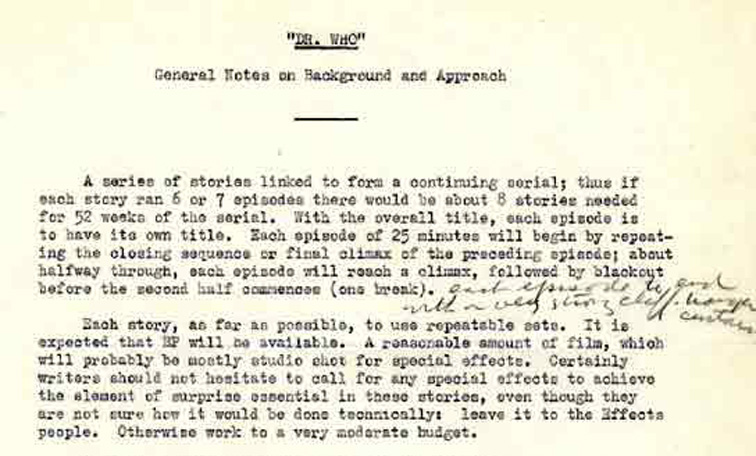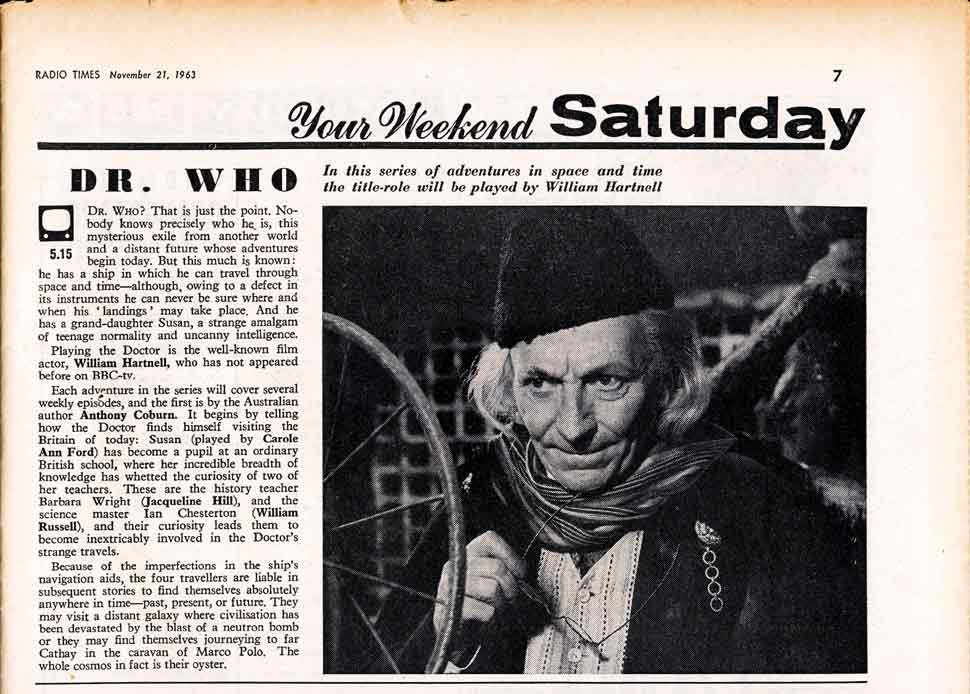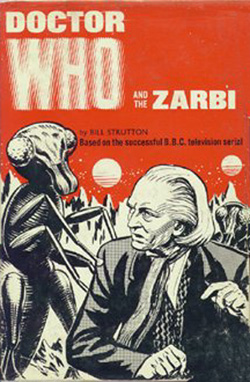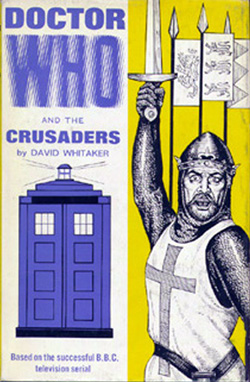Every
now and then, I read comments from Whovians about how the programme is
called: "Doctor Who"
- and how you shouldn't write the title as "Dr. Who".
Also, how the central character is called: "The Doctor",
and should not be referred to as: "Doctor
Who" (or "Dr. Who" for that matter)
But of course, the Truth never
quite that simple
As the Evidence below will show...
.
[Download a PDF version of this article HERE]
The Programme
Yes,
the programme is
titled: "Doctor
Who", but from the very beginning
– in fact from before
the
beginning, the title has also
been written as: “DR WHO”.
From the BBC Archive
Original
'treatment' (Proposal notes) for the 1963
series:

Source:
http://www.bbc.co.uk/archive/doctorwho/6403.shtml?page=1
And as to
the central character ...
Just as with the programme itself -
from before the
beginning, the central character has also been referred to as:
"DR. WHO".
[From the same original proposal document:]
In the BBC's own 'Radio Times' TV guide
(issue dated 14 November 1963), both the programme and the central
character are called: "Dr. Who"
.
On
page 7 of the BBC 'Radio Times' TV guide
(issue dated 21 November 1963)
there is a short feature on the new programme:

Again,
the programme is titled: "DR. WHO"
"In
this series of adventures in space and time the title-role [i.e. DR. WHO]
will be played by William Hartnell"
This
time, however, in the text of the article itself, the character is also referred to
as: "the Doctor".
So, it would seem that, from the outset, both: "the Doctor" and:
"Dr.Who" were correct ways of referring to the character.
.
In the same issue of the BBC 'Radio Times' TV guide
- in the actual listings for 23 November,
1963 [the first ever Episode], again we see the programme titled as
"DR. WHO", and William
Hartnell's character is also listed as: "Dr. Who"
And so it would be continuously throughout the years up into
the fourth incarnation of the central character.
Although
he was primarily referred to as "the Doctor" in-episode, he
was referred to as: "Dr. Who" in the episode listings:
Also,
for the first eighteen years of the programme's history (1963 -
1981), in the closing credits
for the first four incarnations of the Time Lord, the
character is listed as either: "Dr. Who" or: "Doctor
Who" - not as: "The Doctor"
In
fact, it is not until the beginning of the fifth (Davison) incarnation
that the character is listed in the credits as: "The Doctor" -
something which would also continue through the Colin Baker
and
Sylvester McCoy years, up to the suspension of the programme.
When the programme returned to television in 2005, the character was
once again listed as: "Doctor Who"
.In the final episode of the Eccleston era: "The Parting of the Ways", the credits include:
"and introducing DAVID TENNANT as Doctor Who"
It was only in the Tennant era proper, beginning with the Christmas
Special: "The Christmas Invasion", that the character was again listed
as:
"The Doctor"
It
seems fairly clear that it was acceptable, for those actually
working on the programme, to refer to the character as: " Dr. Who".
In
an interview promoting the story: "The Three Doctors" (December '72 -
January '73), Barry Letts, the programme's then
producer, explains
"The new story is that there is a black hole in space through which
cosmic energy is draining. Everybody is helpless. Even Dr. Who - if he
is alone. So the only people he can draw on to deal
with it are his other selves."
And Verity Lambert, the
programme's original producer, states: "I cast William Hartnell as
Dr.Who, after seeing him playing a rugby talent scout in the Richard
Harris film This Sporting Life."
.
In fact, right up to the end of season 18, the character was still
officially being referred to as: "Doctor Who":
[Production paperwork for the story: "The Keeper of Traken" ]
Admittedly,
season 16 had seen one story: "The Power of Kroll" where the production
paperwork identified the character as "The Doctor".
Then in season
18, three of the seven stories also saw the character listed as "The
Doctor" ["The Leisure Hive", "Full Circle" & "Logopolis"]
Yet it
was only really with the last of these - the very last story of season
18 and the final story of Tom Baker's tenure - that the character
reference formally changed to: "The Doctor" in the production paperwork.
And even then, there would be a small handful of stories where - in the
production paperwork - the character would still be identified as:
'Doctor Who'
[i.e. "Four to Doomsday", "The King's Demons", "Resurrection of the Daleks", "Time and the Rani" & "Battlefield"]
Also,
from 1966 to 1986,
Annuals were produced to accompany the programme. [No
annual was produced for 1972]
All of the annuals from 1966 to 1979
were titled: "THE DR WHO ANNUAL". Only in 1980 did the title
change to: "DOCTOR WHO".
The
second annual (1967) simply states:
"As played by WILLIAM HARTNELL", and the annuals for '68, '69, and '70
state: "As played by PATRICK THROUGHTON".
However, all of the annuals from 1971 to 1981 clearly
refer to the character as: "DR WHO"
The Annuals for '71, '73, '74, and '75 bear the wording: “Starring
JON PERTWEE as DR WHO”.
Those for '76, '77, '78, '79, '80, and '81 -
"Starring TOM BAKER as DR WHO”
.
.And of course, there were also the Doctor Who novelisations, beginning in 1964 with:
[Paperback Edition]
."Dr WHO in an exciting adventure with the Daleks"
.
This was followed in 1965 by: "Doctor Who and the Zarbi", and: "Doctor Who and the Crusaders"
 |  |
These
were reprinted in 1973, and in the years from '73-'94 they were
followed by somewhere in the region of 150 further novelisations - of
which, 66 out of the first 70, had titles clearly referencing the
Time Lord as:
'Doctor Who'
Doctor Who and the
Auton Invasion
Doctor Who and the Cave
Monsters
Doctor Who and the
Doomsday Weapon
Doctor Who and the Day
of the Daleks
Doctor Who and the
Dæmons
Doctor Who and the
Sea-Devils
Doctor Who and the
Abominable Snowmen
Doctor Who and the
Curse of Peladon
Doctor Who and the
Cybermen
Doctor Who and the
Giant Robot
Doctor Who and the
Terror of the Autons
Doctor Who and the
Green Death
Doctor Who and the
Planet of the Spiders
Doctor Who and the Loch
Ness Monster
Doctor Who and the
Dinosaur Invasion
Doctor Who and the
Tenth Planet
Doctor Who and the Ice
Warriors
Doctor Who and the
Revenge of the Cybermen
Doctor Who and the
Genesis of the Daleks
Doctor Who and the Web
of Fear
Doctor Who and the
Space War
Doctor Who and the
Planet of the Daleks
Doctor Who and the
Pyramids of Mars
Doctor Who and the
Carnival of Monsters
Doctor Who and the
Seeds of Doom
Doctor Who and the
Dalek Invasion of Earth
Doctor Who and the
Claws of Axos
Doctor Who and the Ark
in Space
Doctor Who and the
Brain of Morbius
Doctor Who and the
Planet of Evil
Doctor Who and the
Mutants
Doctor Who and the
Deadly Assassin
Doctor Who and the
Talons of Weng-Chiang
Doctor Who and the
Masque of Mandragora
Doctor Who and the Face
of Evil
Doctor Who and the
Horror of Fang Rock
Doctor Who and the Tomb
of the Cybermen
Doctor Who and the Time
Warrior
Doctor Who and the
Android Invasion
Doctor Who and the
Sontaran Experiment
Doctor Who and the Hand
of Fear
Doctor Who and the
Invisible Enemy
Doctor Who and the
Robots of Death
Doctor Who and the
Image of the Fendahl
Doctor Who and the War
Games
Doctor Who and the
Destiny of the Daleks
Doctor Who and the
Ribos Operation
Doctor Who and the
Underworld
Doctor Who and the
Invasion of Time
Doctor Who and the
Stones of Blood
Doctor Who and the
Androids of Tara
Doctor Who and the
Power of Kroll
Doctor Who and the
Armageddon Factor
Doctor Who and the Keys
of Marinus
Doctor Who and the
Nightmare of Eden
Doctor Who and the
Horns of Nimon
Doctor Who and the
Monster of Peladon
Doctor Who and the
Creature from the Pit
Doctor Who and the
Enemy of the World
Doctor Who and An
Unearthly Child
Doctor Who and the
State of Decay
Doctor Who and
Warriors' Gate
Doctor Who and the
Keeper of Traken
Doctor Who and the
Leisure Hive
Doctor Who and the
Visitation
Doctor Who and the
Sunmakers
And then of course, in London's newly-completed G.P.O. Tower:
Some 'WHOVIAN SOCIAL HISTORY':
Numerous press clippings etc,
which include reference (however brief)
to the Time Lord as 'Doctor Who'
can be viewed HERE




